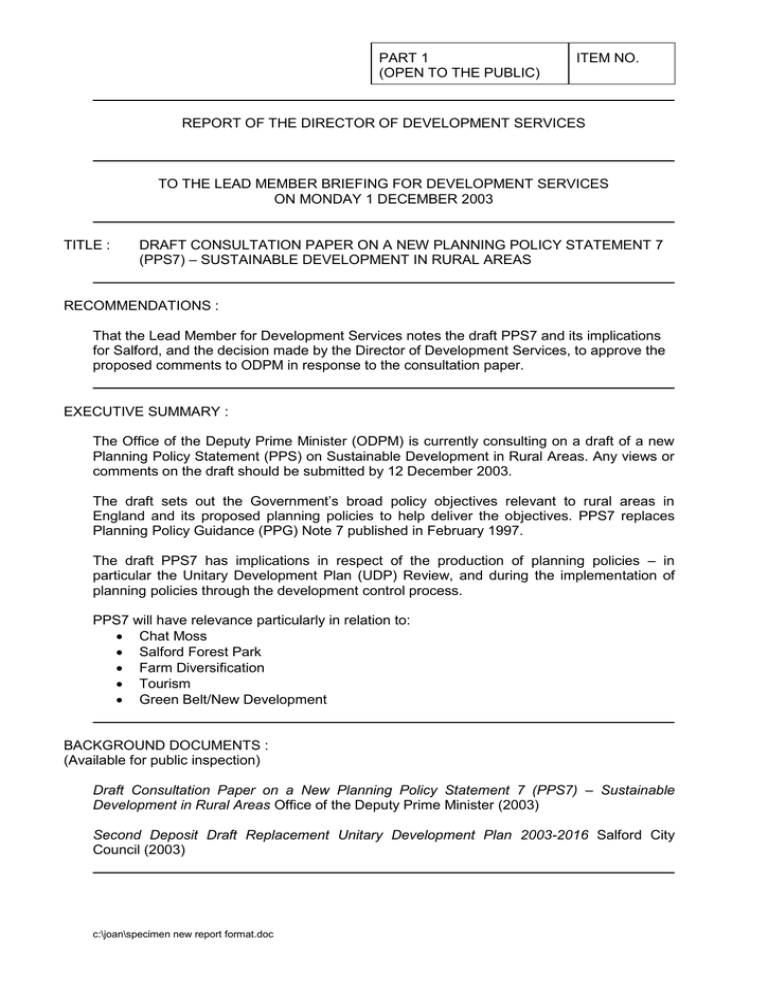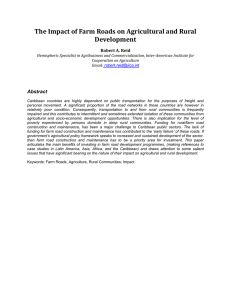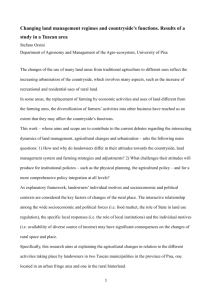PART 1 ITEM NO. (OPEN TO THE PUBLIC)
advertisement

PART 1 (OPEN TO THE PUBLIC) ITEM NO. REPORT OF THE DIRECTOR OF DEVELOPMENT SERVICES TO THE LEAD MEMBER BRIEFING FOR DEVELOPMENT SERVICES ON MONDAY 1 DECEMBER 2003 TITLE : DRAFT CONSULTATION PAPER ON A NEW PLANNING POLICY STATEMENT 7 (PPS7) – SUSTAINABLE DEVELOPMENT IN RURAL AREAS RECOMMENDATIONS : That the Lead Member for Development Services notes the draft PPS7 and its implications for Salford, and the decision made by the Director of Development Services, to approve the proposed comments to ODPM in response to the consultation paper. EXECUTIVE SUMMARY : The Office of the Deputy Prime Minister (ODPM) is currently consulting on a draft of a new Planning Policy Statement (PPS) on Sustainable Development in Rural Areas. Any views or comments on the draft should be submitted by 12 December 2003. The draft sets out the Government’s broad policy objectives relevant to rural areas in England and its proposed planning policies to help deliver the objectives. PPS7 replaces Planning Policy Guidance (PPG) Note 7 published in February 1997. The draft PPS7 has implications in respect of the production of planning policies – in particular the Unitary Development Plan (UDP) Review, and during the implementation of planning policies through the development control process. PPS7 will have relevance particularly in relation to: Chat Moss Salford Forest Park Farm Diversification Tourism Green Belt/New Development BACKGROUND DOCUMENTS : (Available for public inspection) Draft Consultation Paper on a New Planning Policy Statement 7 (PPS7) – Sustainable Development in Rural Areas Office of the Deputy Prime Minister (2003) Second Deposit Draft Replacement Unitary Development Plan 2003-2016 Salford City Council (2003) c:\joan\specimen new report format.doc ASSESSMENT OF RISK Low THE SOURCE OF FUNDING IS N/A LEGAL ADVICE OBTAINED N/A FINANCIAL ADVICE OBTAINED N/A CONTACT OFFICER : Elizabeth Dixon (x3659) WARD(S) TO WHICH REPORT RELATE(S) Irlam & Cadishead, Pendlebury, Worsley & Boothstown, and Winton KEY COUNCIL POLICIES Unitary Development Plan: ST10: Recreation Provision ST11: Location of New Development EN1: Development affecting the Green Belt EN2: Worsley Greenway EN4: Agricultural Land EN5: Farm Diversification EN6: Irwell Valley R2: Provision of New Recreation Land and Facilities R4: Key Recreation Areas DETAILS (Continued Overleaf) c:\joan\specimen new report format.doc Draft Consultation Paper: New Planning Policy Statement 7 (PPS7) – Sustainable Development in Rural Areas 1. Purpose of Note: 1.1 The Office of the Deputy Prime Minister is currently consulting on a draft of a new Planning Policy Statement (PPS) on Sustainable Development in Rural Areas. Any views and comments on the draft should be submitted by 12 December 2003. 1.2 The draft sets out the Government’s broad policy objectives relevant to rural areas in England, and its proposed planning policies to help deliver the objectives. PPS7 replaces Planning Policy Guidance (PPG) Note 7 published in February 1997. It seeks to provide a shorter, focused statement of national planning policies and as such most of the policies reproduce, or are closely based on, existing policies in PPG7. There are some new policies and some have been expanded. 1.3 The policies set out in the statement will need to be taken into account in the preparation of development plans (or their successor) and may be material to planning decisions on individual planning applications. 2. PPS7 Objectives and Principles: 2.1 Objectives i) To raise the quality of life and environment in rural areas. ii) To promote more sustainable patterns of development and support an urban renaissance. iii) To make sustainable improvements in the economic performance of all English regions and, over the long term, reduce the persistent gap in growth within and between the regions. iv) To promote sustainable, diverse and adaptable agricultural sectors. 2.2 Key Principles i) Decisions on development proposals should be firmly based on sustainable development principles – an integrated approach to the consideration of social progress, effective protection of the environment, prudent use of natural resources, and maintaining high and stable levels of economic growth and employment. ii) Good quality, carefully-sited development within existing towns and villages should be allowed where it meets local economic and community needs (including affordable housing for identified local needs), maintains or enhances the local environment, and does not conflict with other planning policies. iii) Larger scale developments should be located in or near to towns or other service centres that are accessible by public transport, walking and cycling. iv) New development away from existing settlements, or outside areas allocated for development in development plans, should be strictly controlled; in particular, isolated new houses in the countryside require special justification. v) Priority should be given to the re-use of previously-developed (brownfield) sites in preference to the development of greenfield sites, except in cases where brownfield sites perform so poorly in terms of sustainability considerations in comparison with greenfield sites. 3. Summary of PPS7 Policy Contents 3.1 Sustainable Rural Communities, Rural Businesses and Services i) Location of Development ii) Business Development and Employment iii) Community Services and Facilities iv) Housing v) Re-Use of Buildings within or adjacent to Towns and Villages vi) Design and the Character of Rural Settlements 3.2 The Countryside c:\joan\specimen new report format.doc i) ii) iii) iv) v) vi) 3.3 Countryside Protection and Development in the Countryside Re-Use of Buildings in the Countryside Replacement of Buildings in the Countryside Designated Areas Local Countryside Designations The Countryside around Cities and Towns Agriculture, Farm Diversification, Equine-related Activities and Forestry i) Agricultural Development ii) Best and Most Versatile Agricultural Land iii) Farm Diversification iv) Equine-Related Activities v) Forestry 3.4 Tourism and Leisure i) Tourist and Visitor Facilities ii) Tourist Accommodation 4. Salford 4.1 The rural areas of Salford are largely covered by Green Belt designation, and are mainly of urban fringe character subject to considerable development pressures. There is a significant proportion of land categorised as high quality agricultural land. 4.2 Chat Moss: The largest area of Salford’s countryside is known as Chat Moss. This is a unique stretch of peat-based land, drained for agricultural purposes, resulting in high quality agricultural land. Principal issues regarding the rural areas in Salford include farm diversification and revitalising the farming economy, protecting the urban fringe and Green Belt area from inappropriate development, protecting best and most versatile agricultural land, and increasing the tourism potential and accessibility of the rural areas for the urban population of Salford. Additionally, there are areas of land with the potential for restoration to mossland habitats of high nature conservation importance and land currently subject to peat extraction. 4.3 Salford Forest Park: The potential for a major recreation proposal is under consideration in 4.4 Farm Diversification: The agricultural area of Salford is currently undergoing structural terms of Salford Forest Park planning application. Such a development raises specific issues regarding large-scale recreation and tourism development in the Green Belt. economic changes. However, there are significant possibilities available through the quality of agricultural land and its proximity to a large population. Possibilities include new cropping regime, recreation, community forest, and farm produce/added value. 4.5 Tourism: Salford’s countryside is ideally located in close proximity to a large urban catchment area for increased opportunities for the promotion of tourism. An existing constraint to this arises from limited public access to the wider countryside area in Salford. 4.6 Green Belt/New Development: The majority of Salford’s Countryside is designated as Green Belt. Any development proposals, including those relating to farm diversification, and leisure and tourism are subject to green belt policy which inhibits innovation and change. 5. Implications of PPS7 for Salford 5.1 The draft PPS7 has implications in respect of the production of planning policies – in particular the Unitary Development Plan (UDP) review, and during the implementation of planning policies through the development control process. 5.2 The Countryside around cities and towns/Green Belt: Draft PPS7 does not change national green belt policy guidance; this continues to be covered by PPG2. However, the draft PPS proposes that planning policies should address the particular land use issues and opportunities to be found in the countryside around urban areas, recognising its importance to those who live or work there, and also in providing the nearest and most accessible countryside to urban residents. c:\joan\specimen new report format.doc Bearing in mind that Chat Moss is designated as green belt, it is considered difficult to carry out major economic change without infringing green belt policy. The policy balance continues to be in favour of the status quo which will limit change other than those that will maintain openness and comply with the key tests of green belt. It is thought to be particularly important to develop a shared vision for Salford’s rural and urban fringe areas, particularly on Chat Moss. 5.3 Best and Most Versatile Agricultural Land: 5.4 Farm Diversification: The presence of best and most versatile agricultural land (defined as land in grades 1, 2 and 3a of the agricultural land classification) should be taken into account alongside other sustainability considerations (e.g. biodiversity; the quality and character of the landscape; its amenity value or heritage interest; accessibility to infrastructure, workforce and markets; maintaining viable communities; and the protection of natural resources, including soil quality) when determining planning applications. Where significant development of agricultural land is unavoidable, the use of areas of poorer quality land (grades 3b, 4 and 5) should be sought in preference to that of a higher quality, except where this would be inconsistent with other sustainability considerations. Little weight in agricultural terms should now be given to the loss of agricultural land in grades 3b, 4 and 5. If any undeveloped agricultural land is appropriate for development, any adverse effects on the environment should be minimised. It is for local planning authorities to decide whether best and most versatile agricultural land can be developed, having carefully weighed the options in the light of competent advice. Development plans should include policies that identify any major areas of agricultural land that are planned for development. Policies to protect specific areas of best and most versatile agricultural land from speculative development may also be included in the development plan. This could prove particularly important in protecting high quality land from long term destruction by mineral industry, particularly peat extraction. Development plans should set out the criteria to be applied to planning applications for farm diversification projects. Well-conceived farm diversification schemes for business purposes, consistent in their scale with their rural location, should be supported. This applies equally to farm diversification schemes around the fringes of urban areas. Favourable consideration should be given to proposals for diversification in Green Belts where the development preserves the openness of the Green Belt and does not conflict with the purposes of including land within it. Where farm diversification proposals in the Green Belt would result in inappropriate development in terms of PPG2, any wider benefits of the diversification may contribute to the ‘very special circumstances’ required by PPG2 for a development to be granted planning permission. Farm diversification should not result in excessive expansion and encroachment of building development into the countryside. The re-use or replacement of existing buildings, where feasible, should be encouraged. The amenity of any nearby residents or other rural businesses that may be adversely affected by new types of on-farm development should be considered. 5.5 The PPS includes an Annex which sets out policy criteria for new occupational dwellings in the countryside. It proposes that the policy criteria applied to farm and forestry workers’ dwellings should also be applied to countryside dwellings associated with other occupations. 5.6 Tourism and Leisure: Sustainable rural tourism and leisure proposals which benefit rural businesses, communities, and visitors and which utilise and enrich, but do not harm, the character of the countryside, should be supported through plan policies and development control decisions. In areas statutorily designated for their landscape, nature conservation or historic qualities, there will be scope for tourism and leisure related developments, subject to appropriate control over their number and location to protect environmental quality. Close assessment is required for large-scale tourism and leisure developments in rural areas in terms of sustainability. c:\joan\specimen new report format.doc 5.7 Two other areas which have undergone policy change through this draft PPS relate to isolated new housing in the countryside and local countryside designations: PPG7 had allowed large, high quality houses to be built in the open countryside, this exception is not included in the PPS. Clearly this is a case in point where this proposal would be in conflict with green belt policy. The draft PPS requires local countryside designations to be removed through the development plan review process and adopt criteria-based policies for the location and design of rural development throughout the area. 6. Adequacy of UDP Policies 6.1 The Second Deposit Draft Replacement Unitary Development Plan 2003-2016 (draft Review UDP) incorporates a number of policies which cover the issues raised in the draft PPS7. These include: ST10 Recreation Provision ST11 Location of New Development EN1 Development affecting the Green Belt EN2 Worsley Greenway EN4 Agricultural Land EN5 Farm Diversification EN6 Irwell Valley R2 Provision of New Recreation Land and Facilities R4 Key Recreation Areas R5 Countryside Access Network 6.2 EN4: Agricultural Land The approach taken in policy EN4 of the second deposit draft Review UDP, relating to the protection of higher grade agricultural land classifications and the hierarchical method, appears to be in accordance with the guidance proposed by the draft PPS. 6.3 Policy EN5: Farm Diversification Salford’s approach to farm diversification is supportive where development proposals are consistent with other policies and proposals of the plan. It sets out examples of farm diversification methods which may be considered acceptable, rather than outlining the criteria to be applied during the planning application process. 6.4 Tourism There are a number of proposed policies which provide a framework through which sustainable rural tourism can be supported, rather than a single policy (i.e. EN1; EN2; EN5; EN6; R2; R3; R4; R5). 6.5 Occupational Dwellings The main policy for dealing with new dwellings in the countryside in the draft review UDP is EN1: Development affecting the Green Belt. This considers the construction of new buildings within the Green Belt to be inappropriate unless it is for one of three specific reasons, one of which includes agriculture and forestry purposes. The Annex further requires development plans to set out the policies for the retention or removal of agricultural and forestry occupancy conditions. The review UDP does not cover the extent of detail provided in the Annex. 6.6 Nature Conservation An important element of Salford’s countryside are the areas of peat with potential to restore to mossland habitat for nature conservation purposes. The PPS does not focus on nature conservation issues, although effective protection of the environment is part of the first key principle, which requires decisions on development proposals to be firmly based on sustainable development principles. Additionally, the PPS advocates that planning authorities should continue to protect the countryside for the sake of its intrinsic character and beauty, the diversity of its landscapes and wildlife and the wealth of natural resources. 6.7 Conclusion Overall, the proposed policies in the second deposit draft review UDP are in accordance with the proposals in draft PPS7. The exceptions to this are in relation to new occupational dwellings in the countryside and the lack of criteria to be applied during the planning application process for farm diversification applications. Neither of these are considered to constitute fundamental flaws in the plan. 7. Comments to the ODPM c:\joan\specimen new report format.doc 7.1 It is proposed that the following issues should be raised in the response to ODPM. Generally, the draft PPS7 is a welcome direction which recognise the increasing importance of countryside planning policies and their impact on the regional and local economy. However there are a number of issues relevant to the countryside in Salford requiring further clarification. These are outlined below: a) There needs to be a recognition that the specific tests of what is acceptable in Green Belt can act as a major constraint on restructuring the agricultural economy in an urban fringe location. This may even make farm diversification difficult where new buildings and infrastructure may be preferable to the reuse of existing, outdated farm buildings. This tension may make it more difficult to achieve a sustainable economy in the urban fringe than in the wider countryside where there is no Green Belt constraint. b) Urban fringe continues to be treated as an add-on with no proper attempt to explain how planning policies in the urban fringe can support an urban renaissance (in line with Objective ii of PPS7). c) There is a lack of guidance with respect to major recreation/sports facilities. This falls between PPG17, PPG2 and PPS7. d) There is a lack of any reference to the importance of good design. 7.2 The letter detailing these points is attached in Appendix 1. Malcolm Sykes Director of Development Services c:\joan\specimen new report format.doc



